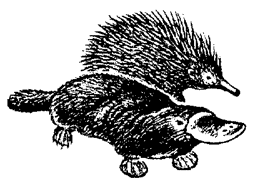 |
Science Frontiers ONLINE No. 74: Mar-Apr 1991 |
|
|
Echidna Eccentricities
 Monotremes: platypus (below); one of two species of echidnas (above) |
There are more anatomical peculiarities, but let us focus on the echidna's strange behavior during the mating season. At this time, 2 to 8 echidnas can be seen roaming the Australian bush in "trains" headed by a female with the smallest male acting as a caboose. When mating time arrives, the female anchors herself to a tree with her forelegs. To-gether the males dig a circular "mating rut" up to 10 inches deep around the tree. (Australians have puzzled over these circular trenches for years.) Eventually the strongest male evicts the other males from the trench, the purpose of which now becomes apparent. As the old saying goes, porcupines make love very. Well, the echidna has an interesting technique; he simple lays on his side in the trench under the female! (Rismiller, Peggy D., and Seymour, Roger S.; "The Echidna," Scientific American, 264:96, February 1991.)
Reference. Many additional echidna "eccentricities" can be found in our catalog Biological Anomalies: Mammals I and II. For more information on these books, visit: here.